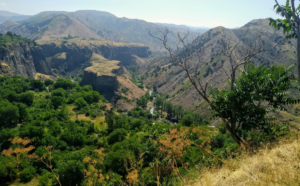Eco Tourism in Armenia

Armenian Bezoar Goat
Ecotourism in Armenia
When people think about eco-tourism, they are usually looking at several mainstream destinations. The devoted eco-tourists, however, the ones who are well informed about what ecotourism is, know very well that eco-destinations can be found practically everywhere. This is why they never give up searching for the new and unexplored.
With this article, we start a series of materials the purpose of which is to talk about what makes Armenia an amazing eco-destination – about Armenia’s biological diversity, wildlife, and the numerous eco-tourism activities. Also, to place it on the radar screen of popular eco-tourism sites.
Let us go briefly over the definition: What is eco-tourism all about?
One very simplistic definition of ecotourism is that it is about preserving what is there – the natural areas and wildlife, avoiding physical or environmental degradation. It means responsibly treating the communities they visit – not leaving any damage behind, minimizing water and air pollution and tourism waste. It is also respect for cultural heritage and traditions of the host destination.
Ecotourism typically involves travel to destinations where flora, fauna, and cultural heritage are the primary attractions. This is exactly what Armenia offers.
What do eco-tourists look for?
Ecotourists typically look for experiences that provide a sense of closeness to the natural attractions and local communities. Ecotourism is a form of tourism involving visiting fragile, pristine and relatively undisturbed natural areas.
It involves responsible travel to areas while conserving the environment and improving the well-being of local people. The goal is to preserve the destinations so that future generations may experience these destinations relatively untouched by human intervention.
Thus, an eco-tourism is different from a regular tourist in the sense that, he or she is mindful of his environment, in most cases contributing to the sustainability of such surroundings.
And what does Armenia offer to eco-tourists?
Does Armenia present any interest from an eco-tourist’s perspective? How does it fit into the global “eco-tourism” picture?
To answer, it is necessary to mention this: there are 35 so-called “biodiversity hotspot” sites on the earth. These sites support nearly 60% of the world’s plant, bird, mammal, reptile, and amphibian species, with a very high share of those species as endemics.
Armenia is one of these 35 “biodiversity hotspots”!
A few facts about the country’s biodiversity: Located at the border of Europe and Asia between the Black Sea and the Caspian Sea it features over 3,800 plant and more than 17,500 animal species (including 545 species of vertebrates). The rate of endemism is also very high – 11% of the fish, 17% of the amphibians, 24% of the reptiles, 23% of the birds and 24% of the mammals in Armenia have been estimated to be rare and endangered.
The Caucasian Leopard, the Bezoar Goat, the Syrian Brown Bear, the Marbled Polecat and the Common Otter are among the rare species one can see here.
That said, it simply means, there are innumerable interests eco-tourists will find in Armenia. It will come as a great surprise of how many things they can do here.
To name a few, one can do birdwatching, wildlife watching, hiking, climbing, mountaineering, caving, cycling, mountain-biking, horse trekking, cross-country skiing, ski-touring, boating, swimming, camping, and spa tourism.
In our next articles, we will present Armenia’s National Parks, and the activities one can do there.
Tags: National Parks, State Reserves




